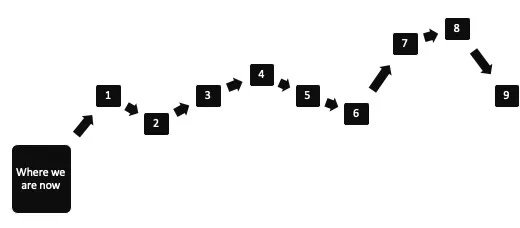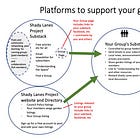Where are we going? How will we get there?
These are the questions that shape our conversations as we plan and manage group projects.
Have you every been in one of those groups or clubs that have regular long meetings with lots of talk that leads nowhere and you come away thinking: I’ll never get those two hours of my life back.
Or groups where people keep pulling in different directions so there’s lots of noise and activity but you’re left wondering if the outcomes are worth the effort.
Or there is one dominant person who leads the group and decides what everyone will do. You can follow, or leave.
Conversations and Questions
The tools needed to hold the group together and keep everyone moving in the same direction, adding and adapting as unexpected hurdles and opportunities arise, are carefully managed conversations and questions.
It’s important that we ask ourselves these two questions and revisit them often.
Where are we going and how will we get there?
1️⃣ Where are we going?
For successful collaborations, the core team needs to find a shared purpose that includes the goals of all participants. You might want to adjust the proposed destination for localised projects.
The Big Shady Lanes Picture: What if we could develop and nurture a network of individuals and groups all around Australia working on localised verge garden projects to transform their neighbourhoods at the scale and speed we need?
Your Local Group Picture: What if our group could transform our neighbourhood with resident-planted verge gardens and council street trees with each local group getting the support and resources they need?
A Local Council Area Picture: What if Council and community groups and individual residents could work together collaboratively to green our streets?
What would that look like? How would it work?
And for a different sort of group:
Regen Brisbane: What would it be like if the Greater Brisbane area transitioned to a Doughnut economy - staying within the planetary boundaries while meeting the needs of all the people within? What would that future look like? How might we contribute towards making that happen?
2️⃣ How will we get there?
We get there by looking at all the possible options starting from where we are and what we have resources we have available, and choosing the one that is most doable and most likely to bring in rewards to justify the effort and resources involved. Some call it the best return on investment. In Strategic Doing, they call it the Big Easy.
As we progress, we keep asking ourselves this question. Did our last experiment get us where we expected? Can we learn anything from that? Could we adjust and improve? Have new options emerged? What will we do next?
By using existing assets, and combining them in new ways, we create more resources and opportunities. (recombinant innovation)
By building on each success, we find more opportunities emerge.
We Assets Do We Start With?
We all bring different things to the table, some obvious, some we might not even realise are assets ourselves. Don’t forget external assets - assets we don’t own but are available for us to use.
Two external assets that we start with are the land available on our verges, and the council verge garden policies. Other readily available assets could be social media groups, public libraries, local organisations, Substack, etc.
The assets I bring are the Shady Lanes Platform, my experience and knowledge in various fields, and my personal network.
What are your assets? It is a good habit to start recognising all the assets you have, even if you don’t want to offer them in the current situation or circumstances. Your assets could include things like skills, knowledge, time, money, who you know, membership of community groups.
Nobody can demand assets from others, you can offer your own assets and should only do so if you are willing and able to deliver.
Your network is bigger than you think. A friend of a friend, the person down the street who stops to talk about your garden, the facebook group, the council officers you deal with…
By combining our assets, we can do a lot more than any of us could do alone - and more than can be done in a traditional way of working.
The more diverse your group members, the more diverse assets your group will have and the more other networks you can hook into.
Internet assets
The internet provides opportunities and platforms for networks. Just like our personal network, it’s the connections between the dots that make it so powerful.
Your group’s Substack and other platforms (LinkedIn, facebook, etc), plus your profiles and listings on other Shady Lanes websites, are the core of your group’s online network. You can use these to promote your group, provide examples, draw new members into your group.
For more on setting up a group page on Substack this, see…
For paid subscribers, please use the comments for questions and discussion.






